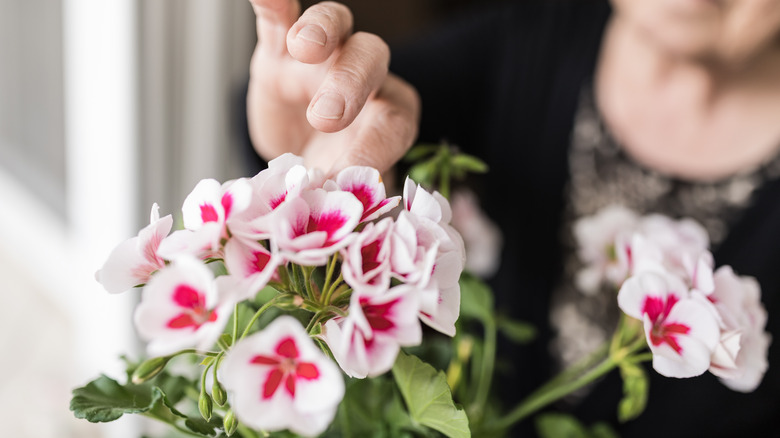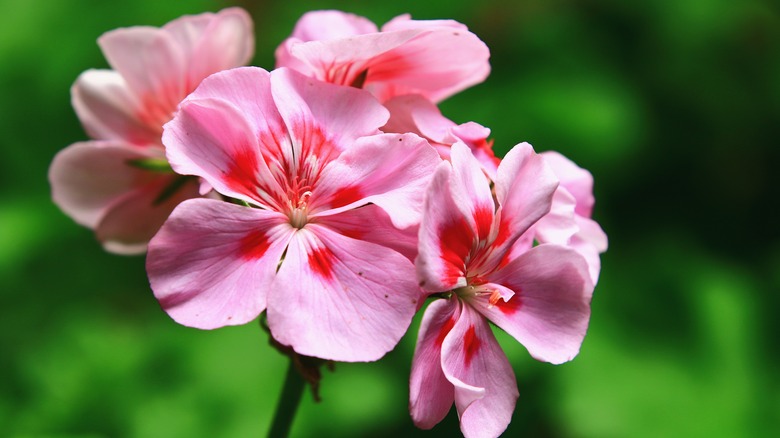An outdoor staple every spring and summer, geraniums are easily spotted in gardens thanks to their bright hues and sweet, fragrant aromas. Luckily for gardeners looking to spruce up their indoor or outdoor displays, the flowers are also relatively low-maintenance and likely to return each year if grown in the proper environment. On top of adequate water, sunshine, and fertilization, select species of geraniums need to be deadheaded, or trimmed, frequently in order to grow their strongest and produce the most flowers. There’s no precise time frame to follow when cutting back these easy-going annuals and perennials. Instead of adhering to an unwavering schedule, simply aim to deadhead your geraniums on a regular basis after the blossoms have reached their peak bloom, snipping the flowers with pruning shears while leaving only the healthiest leaves and stems of the plant intact.
Though deadheading is a simple practice that encourages plants to grow to their fullest potential, not all flowers need it to perform at their best. For instance, deadheading is a more useful technique when tending to pelargoniums as opposed to hardy geraniums, two completely different flower types that are commonly mistaken for the same plant. Here’s more on timing and executing your deadheading process, spotting the differences between pelargoniums and hardy geraniums, and how to determine whether your geranium plant would grow best with or without deadheading.
How to deadhead geraniums

Before diving into the deadheading process, let’s explore the characteristics of geraniums that will help gardeners offer the best care over the course of their lives. Common geraniums are mostly annual flowers that grow best in warm and sunny climates, like those seen across the American South, first beginning to flower in early spring and usually lasting until the end of fall. They enjoy moderate amounts of water, soil with exceptional drainage capabilities, and direct sunlight for around five hours each day. Geraniums begin to bloom about 13 to 15 weeks after being planted, and these seeds should be sown toward the end of winter for a chance at blossoming the following spring.
When deadheading geraniums, snip or pick off faded blooms using handheld shears or your fingers, though shears are recommended in order to make as clean a cut as possible. Trim down to the healthiest set of leaves, removing around 4 to 6 inches of stems each session. Doing so alerts the plant to refocus its energy on growing new, healthy blossoms in place of the dying blossoms, rather than wasting energy attempting to revive the older blooms. It’s best to deadhead when the weather is cool and the individual blossoms are dry, in order to prevent infection from setting into the exposed stems. Gardeners should check for wilting geranium blooms a minimum of once each week to see maximum yield during the plants’ respective growing seasons.
Should all geraniums be deadheaded?

While geraniums are often mistakenly narrowed down to a single species, the term “geranium” is a broad identifier, or genus, classifying over 400 species of flowers, which doesn’t include the variety that many casual plant enthusiasts consider to be geraniums. There are two distinct types of flowers, pelargoniums and cranesbills, which, despite belonging to the same family, differ in appearance and the care that is needed to help them grow to their healthiest and strongest. Cranesbills, also known as hardy or true geraniums, are perennials with strong stems capable of surviving a wide range of environments, including blustery cold and frost. Pelargoniums, in contrast, actually aren’t geraniums at all and consist of five petals that differ in size and positioning around the flower’s center.
A majority of true geraniums would benefit from deadheading, but they don’t need to be tended to as often as pelargoniums. Doing so would only improve the plant’s energy circulation, making the plant look healthier overall rather than accelerating blossom production. Deadheading cranesbills will also increase the probability of the plant returning to bloom after a winter period of dormancy. Gardeners should follow the same routine when deadheading both pelargoniums and true geraniums, but pruning cranesbills as often as their more environmentally sensitive cousins isn’t necessary. Instead, strive to trim back your cranesbill three times during its growing season: once in early spring as it starts to bloom, again in the middle of summer, and once closer to fall.



